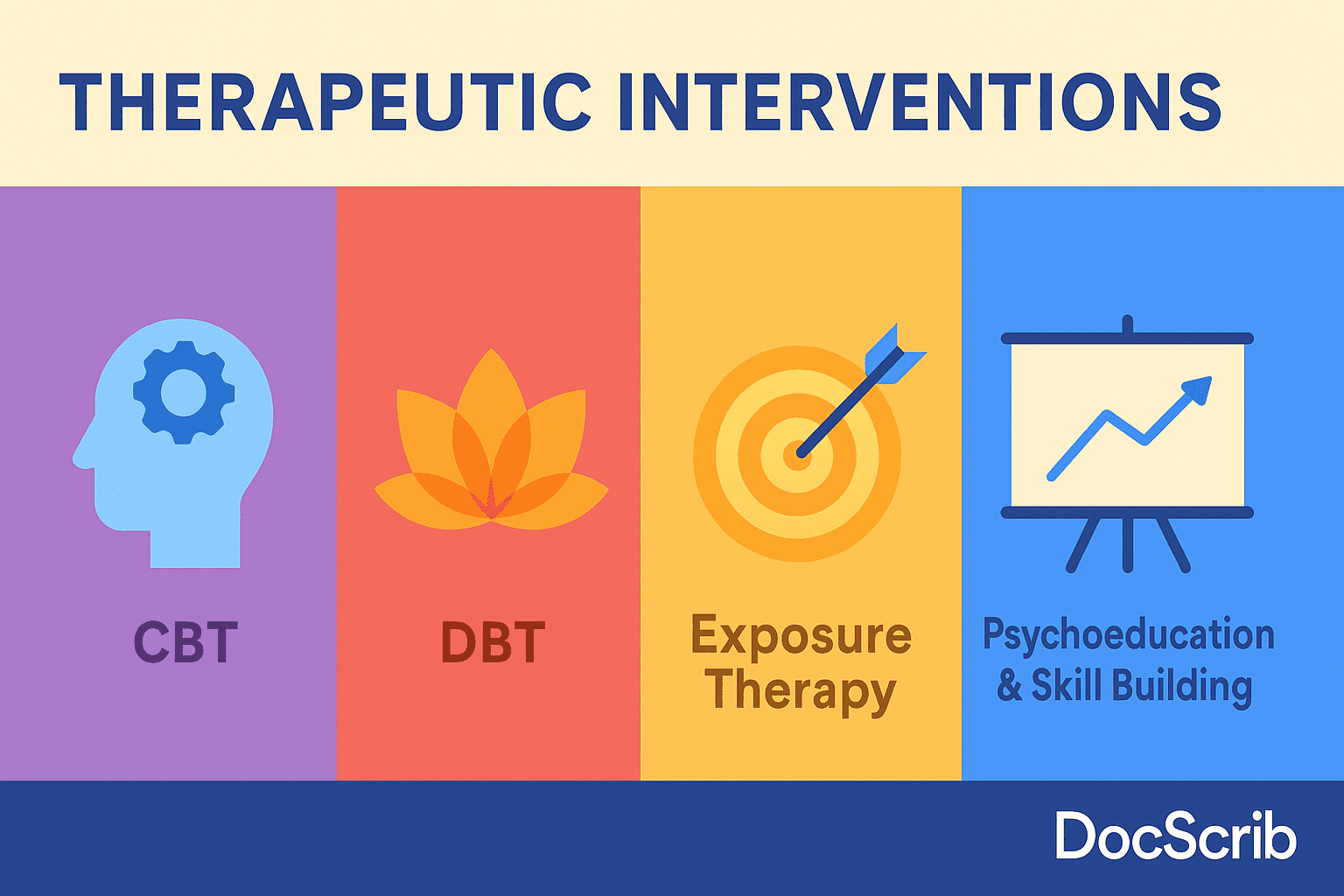Updated on: July 26, 2025
Selecting and applying therapeutic interventions thoughtfully is central to delivering impactful mental health care. This guide explains major evidence-based intervention types, how to match them to presenting concerns, documenting progress, and building an intervention toolkit for diverse client needs.
Why Therapeutic Interventions Matter
Therapeutic interventions are structured techniques therapists use to help clients resolve issues, build skills, and achieve goals. When interventions are tailored and documented properly, they enhance clarity, support insurance compliance, and ensure consistent care. Effective interventions span cognitive, behavioral, psychodynamic, experiential, and relational frameworks.
Core Categories of Therapeutic Interventions
Cognitive-Behavioral Techniques (CBT and Third-Wave)
- Cognitive restructuring: helps challenge and reframe distorted thought patterns.
- Behavioral activation: encourages engagement in positive activities to counter depression.
- Mindfulness-based CBT & ACT: include cognitive defusion, acceptance, and values-based action.
Dialectical Behavior Therapy (DBT)
- Focuses on emotional regulation, distress tolerance, interpersonal effectiveness, and mindfulness skills. Particularly effective for emotion dysregulation and borderline personality conditions.
Exposure Therapy & Trauma-Focused CBT
- Exposure Therapy: Gradual or flooding-based exposure to fears while preventing safety behaviors to diminish anxiety. Especially effective for PTSD, OCD, phobias.
- Trauma-Focused CBT (TF-CBT): Structured phases (PRACTICE model) including psychoeducation, emotional regulation, trauma narration, exposure, and parent collaboration.
Interpersonal Psychotherapy (IPT)
- Short-term, attachment-focused therapy emphasizing interpersonal roles and mood link, typically 12–16 sessions. Effective for depression and relational stress.
Psychodynamic and Humanistic Approaches
- Focus on self-awareness, unconscious patterns, attachment, early relationships, personal growth, and emotional insight. Tailored through narrative exploration and relational focus.
Expressive & Creative Therapies (Art, Music, Drama)
- Use creative media to help clients express and process emotions. Effective for trauma, anxiety, and developmental challenges.
Psychoeducation and Skill Building
- Teaching about symptoms, physiology (e.g., anxiety response), coping strategies, and rationale for interventions. Essential as foundation for anxiety and trauma work.
Matching Interventions to Client Needs
| Client Concern | Recommended Interventions |
|---|---|
| Anxiety, phobias | Exposure therapy, CBT, psychoeducation, diaphragmatic breathing |
| Depression | CBT (activation, restructuring), IPT, MBCT |
| Trauma/PTSD | TF-CBT, exposure-based protocols |
| Emotion dysregulation | DBT skills (mindfulness & distress tolerance) |
| Relationship issues | IPT, systemic/Couple/Family interventions |
| Articulation of emotion | Art, music, or drama therapy |
| Obsessive or fearful thinking | Cognitive defusion, ACT principles |
Documenting Interventions in Progress Notes
Each note should include:
- Intervention used (e.g., “Cognitive restructuring targeting automatic negative thoughts.”)
- Client response (e.g. “Engaged well; identified two alternative thoughts.”)
- Objective link to treatment goal or symptom change
Sample Chart
| Component | Example Detail |
|---|---|
| Intervention | Exposure therapy: imaginal exposure to feared memory |
| Client Response | Visualized memory and tolerated discomfort |
| Progress Indicator | Stayed in imagery for 10 min; anxiety dropped from 8 → 5 |
| Link to Goal | Supports reduction in PTSD-related intrusion severity |
Frequently Used Interventions by Condition
Anxiety
- Psychoeducation on anxiety and nervous system
- Cognitive defusion
- Exposure therapy in incremental steps
- Mindfulness & relaxed breathing
- Radical acceptance strategies
Depression
- Behavioral activation & scheduling pleasurable activities
- CBT techniques: restructuring negative beliefs
- IPT interventions targeting relational disturbance
- MBCT for relapse prevention and emotional awareness
Emotion Dysregulation
- DBT modules: distress sit, emotion regulation, interpersonal skills, mindfulness
- Crisis survival plans and opposite action methods
Trauma/PTSD
- TF-CBT phases (PRACTICE model)
- Exposure including in vivo or imaginal
- Narrative processing
- Parent-child conjoint sessions where relevant
Creativity or Expressive Needs
- Art/movement/music/drama prompts to externalize emotion
- Integration of discussion on symbolism and internal state
Case Conceptualization & Intervention Blend
A client with PTSD and avoidance behavior might receive TF‑CBT for trauma, supplemented by DBT distress tolerance, and expressive art therapy to foster emotional integration.
Staff should document chosen modality, rationale, and expected outcomes to tailor and monitor interventions.
Sample Intervention Toolkit
| Therapeutic Approach | Key Interventions | Primary Use Cases |
|---|---|---|
| CBT | Cognitive restructuring, behavioral activation | Anxiety, depression, OCD |
| DBT | Emotion regulation, distress tolerance, mindfulness | Self-harm, emotional dysregulation |
| Exposure / TF-CBT | In vivo exposure, trauma narrative | PTSD, phobias, panic disorder |
| IPT | Role dispute, grief work, communication enhancement | Depression, interpersonal issues |
| Expressive Arts | Art-drama-music metaphor work | Crisis, trauma, low-verbal clients |
| Psychoeducation | Symptom education, breathing, relaxation techniques | Anxiety, early sessions, motivation |
Best Practices & Ethical Notes
- Match intervention to clinical presentation: Avoid boilerplate; adjust based on individual context.
- Use evidence-based practices aligned with empirical support.
- Monitor client preference and cultural fit.
- Document informed consent for interventions that may be intense (e.g. exposure, trauma processing).
- Monitor for harms: Ensure safety during exposure exercises and manage distress triggers.
Outcome Tracking & Progress Evaluation
Track use of interventions over time using structure such as:
- Session log of intervention + response
- Progress metrics (PHQ‑9, GAD‑7, or symptom count)
- Client feedback questionnaires
Future Directions & Innovative Modalities
- Technology-assisted interventions: VR exposure applications, EMDR via digital platforms.
- Integration of biofeedback: Real-time physiological signals to reinforce relaxation and mindfulness.
- Hybrid models: Blending human-led therapy with guided self-administered expressive and cognitive tasks.
Conclusion
Therapeutic interventions are versatile tools that, when applied thoughtfully, support meaningful client change. Whether supporting resilience, shaping cognition, processing trauma, or regulating emotion, the clinician’s intervention toolkit must remain flexible, evidence-based, and responsive.
- Use structured evidence-based interventions tailored to presenting concerns
- Document clearly: intervention, client response, and therapeutic intention
- Track outcomes and adapt when effectiveness plateaus
- Maintain sensitivity to culture, consent, and client preference
By integrating a diverse and well-documented intervention strategy, therapists can guide clients toward effective healing and sustained growth.
Empower your clinical care with a proven toolkit of therapeutic interventions.
Create, document, and deliver evidence-based therapy with ease using DocScrib.
